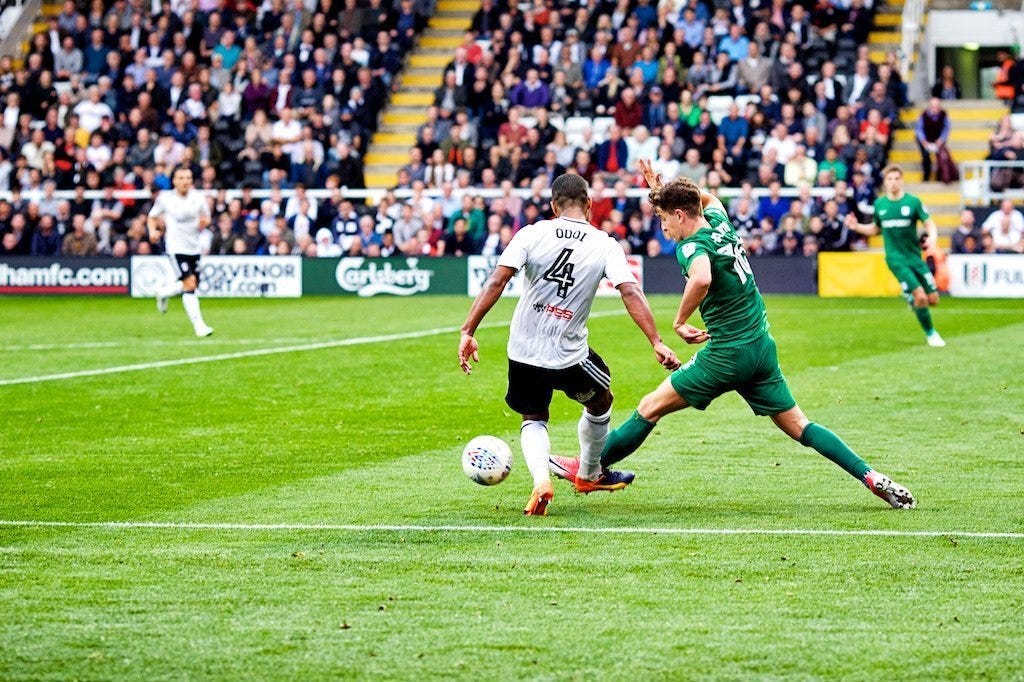Plaudits for Parker: Attacking Fullbacks and Near-Post Runs

Eamon Levin praises Parker’s decision to include his fullbacks in the attack and looks at how the Whites are turning a previously underwhelming offence into a well-drilled machine.
Near-post runs? Fullbacks flying down the flanks? Four players in the box? Where is my Fulham FC and who are these eerily similar-looking players?
I often criticize Scott Parker’s tactics but after recent performances (Barnsley aside, for obvious reasons…) he deserves praise. An albeit mind-numbing nil-nil draw at Charlton was sandwiched between contests against Middlesbrough and Huddersfield that exhibited two of the best offensive performances of the season thus far. An uptick in the fullbacks’ involvement in the front third, players attacking the near post, and a willingness to get into the box are all beginning to turn Fulham’s offence into the juggernaut it was expected to be.
Parker has abandoned his attempt at a tactical upheaval and finally looks to have come to his senses as the team exhibit a greater understanding of football’s fundamentals. It will be this return to basics that pushes the Whites over the hump and into the top two.
Flying Fullbacks
The forward movement of Fulham’s fullbacks in attack has been instrumental in the Whites’ promotion push as of late. To the confusion of many, Parker opted to use his fullbacks conservatively at the beginning of the season. A combination of the more defensive Dennis Odoi and Steven Sessegnon operated on the right while Joe Bryan was visibly reluctant to break lines down the left. Perhaps Parker believed the talent in his front five would be enough to break down opponent’s defences? Or maybe he didn’t trust his defence enough to let his fullbacks join up-front.
Whatever the reason, anyone could see that Knockaert and Cavaleiro’s constant inside movement did nothing to stretch the defence and create space for others to operate. As games passed and Fulham began to enter the run-in, it became glaringly obvious that if the fullbacks were kept back, the Whites would fall short of reaching the top two. It was a momentous decision to move the fullbacks up the field. Matches that otherwise would have resulted in losses or draws earlier in the season have become wins.
The addition of Cyrus Christie to the regular starting XI and the development of Joe Bryan as an attacking option down the left could be the catalyst for a legitimate push into the automatic promotion places. Sessegnon and especially Odoi have been terrific options in the defensive line but Christie provides crucial width and solid pace down the line. The same can be said of Bryan’s marauding runs down the left flank. Of Fulham’s past six goals, four have come from the fullbacks getting into the attacking third and driving balls across the box.
In the past, 1-0 wins like those against Middlesbrough and Blackburn developed into slow-moving stalemates in which the Whites’ offensive firepower quickly flamed out. However, with the fullbacks pushing up, it forced opposition defenders to stay wide, allowing Fulham’s central players room to manoeuvre in crucial moments. Against Middlesbrough, Huddersfield, and Blackburn, Joe Bryan was able to receive passes following overlapping runs and play the ball across the face of goal; once for Knockaert and twice for Mitrovic.
Near-post Power
The Whites’ play in the box has improved massively in recent weeks. In particular, the increased regularity of near-post runs has boosted the number of legitimate scoring chances.
Near-post runs are the crux of any wide attack because they accomplish two tasks. First, they place the attacking player between the ball and the defender, giving him control – he can settle, shoot or move the ball into the box. Second, by attacking the near post, defenders are driven back towards their own goal, opening space for teammates to run into, and pushing back the offside line.
Case in point; Mitrovic’s two near-post finishes in the last two games. Against Huddersfield, he beats his man to Bryan’s cross and slams home into the roof of the net. Against Blackburn, he arrives first and places his body between the ball and his defender with his back to goal. Once the defender commits to a tackle, Mitrovic spins the other way and buries the match winner. Tom Cairney’s goal against Huddersfield is similarly excellent. He places himself between the ball and his defender, giving himself the requisite space to flick the ball up and finish neatly.
Get in the Box!
Fulham’s commitment to getting players in the box demonstrates the desire to score goals. For a team that often sees its talented front-five fall flat, this push to put the ball in the net is something Fulham supporters have been waiting for. While Mitrovic, Knockaert, and Cairney put away their chances in recent games, it’s important to notice that behind them all are at least three other Fulham players making their ways into the box. If Parker can continue his side’s desire to score while maintaining their recent defensive record, automatic promotion is certainly a realistic achievement.
Parker has finally begun to demonstrate his maturity as a decision maker. The best footballing sides execute the simple things and, finally, Fulham are beginning to do just that. With the fullbacks moving forward into the attack, forward players attacking the near post and players committing themselves to get into the box, Parker’s offence is beginning to look like the powerful unit everyone expected it to be. Parker is clearly learning from his mistakes and the team is benefiting.
With 13 games to go, and Leeds well into their annual collapse, I have only one more wish for Parker: take us home.


